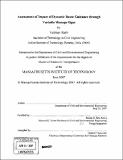| dc.contributor.advisor | Moshe E. Ben-Akiva. | en_US |
| dc.contributor.author | Rathi, Vaibhav | en_US |
| dc.contributor.other | Massachusetts Institute of Technology. Dept. of Civil and Environmental Engineering. | en_US |
| dc.date.accessioned | 2007-10-22T17:30:41Z | |
| dc.date.available | 2007-10-22T17:30:41Z | |
| dc.date.copyright | 2007 | en_US |
| dc.date.issued | 2007 | en_US |
| dc.identifier.uri | http://hdl.handle.net/1721.1/39285 | |
| dc.description | Thesis (S.M.)--Massachusetts Institute of Technology, Dept. of Civil and Environmental Engineering, 2007. | en_US |
| dc.description | Includes bibliographical references (p. 135-139). | en_US |
| dc.description.abstract | Integration of Intelligent Transportation Systems (ITS) technologies with traffic surveillance has the potential of reducing the delays and costs incurred due to non-recurrent congestion through the dissemination of dynamic route guidance to drivers. Variable Message Signs (VMS), installed on freeways, are used for incident management and provide information about the incidents and diversion routes. VMS can prove to be a significant tool used by the Traffic Management Center (TMC) to improve the efficiency of the network by providing dynamic route guidance. Dynamic Traffic Assignment (DTA) tools can be used to generate predictive guidance, and the TMC can disseminate it through VMS to the drivers. However, on-line evaluation of such systems is very costly and there is a need to simulate the real traffic conditions to evaluate the DTA tools before their implementation in the field. The current state of the art is to provide measured travel time information to drivers. The objective of this study will be to evaluate the network performance with the dissemination of predictive route guidance in case of severe incidents through the Variable Message Signs. | en_US |
| dc.description.abstract | (cont.) Evaluation is done by developing a tool using the 'closed loop' integration between MITSIMLab, a microscopic traffic simulator as a proxy for the real traffic conditions, and DynaMIT, a DTA tool that is capable of generating predictive and consistent guidance. Using Genetic Algorithms with the 'closed loop' setup, a methodology is developed to identify VMS locations that result in the best consistent guidance to drivers. A case study is presented showing the benefits of using VMS by simulating incidents of major severity in Lower Westchester County, NY. Application of optimal location methodology and associated advantages in solving the problem is demonstrated with the help of a case study on a synthetic network. Results illustrate the potential and significant benefits obtained through Variable Message Signs. Using the optimal location methodology can improve these benefits even further. | en_US |
| dc.description.statementofresponsibility | by Vaibhav Rathi. | en_US |
| dc.format.extent | 139 p. | en_US |
| dc.language.iso | eng | en_US |
| dc.publisher | Massachusetts Institute of Technology | en_US |
| dc.rights | M.I.T. theses are protected by copyright. They may be viewed from this source for any purpose, but reproduction or distribution in any format is prohibited without written permission. See provided URL for inquiries about permission. | en_US |
| dc.rights.uri | http://dspace.mit.edu/handle/1721.1/7582 | |
| dc.subject | Civil and Environmental Engineering. | en_US |
| dc.title | Assessment of impact of dynamic route guidance through variable message signs | en_US |
| dc.type | Thesis | en_US |
| dc.description.degree | S.M. | en_US |
| dc.contributor.department | Massachusetts Institute of Technology. Department of Civil and Environmental Engineering | |
| dc.identifier.oclc | 172667173 | en_US |
